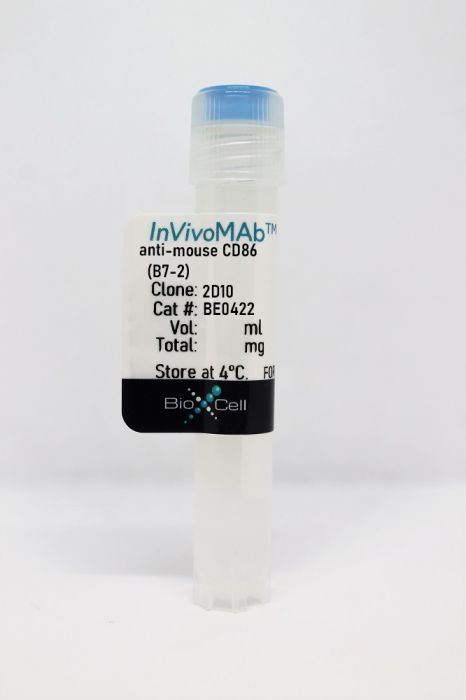InVivoMAb anti-mouse CD86 (B7-2)
Product Details
The 2D10 monoclonal antibody reacts with mouse CD86 also known as B7-2. CD86 is an 80 kDa Ig superfamily member. CD86 is expressed by activated T and B cells, macrophages, and dendritic cells. This ligand binds to CD28 to provide a costimulatory signal necessary for T cell activation and survival, and cytokine production. Additionally, CD80 binds to CTLA-4 which inhibits T cells.Specifications
| Isotype | Rat IgG2b, κ |
|---|---|
| Recommended Isotype Control(s) | InVivoMAb rat IgG2b isotype control, anti-keyhole limpet hemocyanin |
| Recommended Dilution Buffer | InVivoPure pH 7.0 Dilution Buffer |
| Immunogen | Mouse B cell lymphoma cell line 5C2 |
| Reported Applications |
Immunoprecipitation Flow cytometry Functional assays |
| Formulation |
PBS, pH 7.0 Contains no stabilizers or preservatives |
| Endotoxin |
<2EU/mg (<0.002EU/μg) Determined by LAL gel clotting assay |
| Purity |
>95% Determined by SDS-PAGE |
| Sterility | 0.2 µm filtration |
| Production | Purified from cell culture supernatant in an animal-free facility |
| Purification | Protein G |
| Molecular Weight | 150 kDa |
| Storage | The antibody solution should be stored at the stock concentration at 4°C. Do not freeze. |
Recommended Products
Immunoprecipitation, Flow Cytometry, Functional Assays
Chen C, Faherty DA, Gault A, Connaughton SE, Powers GD, Godfrey DI, Nabavi N. (1994). "Monoclonal antibody 2D10 recognizes a novel T cell costimulatory molecule on activated murine B lymphocytes" J Immunol 152(5):2105-14. PubMed
We have developed a panel of rat mAbs against dibutyryl cAMP-activated 5C2 cells. In this panel, one mAb, 1G10, recognized murine B7. Another mAb designated 2D10 did not bind to murine B7 but could recognize a surface molecule expressed only on dibutyryl cAMP-activated 5C2 mouse B lymphoma cells or on LPS-stimulated splenic B cells. This new molecule is referred to as early T cell costimulatory molecule-1 (ETC-1). From both activated 5C2 cells and splenic B cells, mAb 2D10 immunoprecipitated a 59- to 60-kDa protein, which was different from the 47- to 55-kDa murine B7 protein precipitated from the same cell populations. FACS analysis showed that, in contrast to B7, the expression of ETC-1 on 5C2 cells was induced by lower concentrations of dibutyryl cAMP and displayed a faster kinetics. LPS-stimulated splenic B cells expressed relatively low levels of B7 and much higher levels of ETC-1. Importantly, in an Ag presentation assay using activated 5C2 cells as APC, the secretion of IL-2 by C8A3 T hybrids was partially inhibited by mAb 2D10 alone and completely blocked by combination use of mAbs 2D10 and 1G10 in a dose-dependent and synergistic fashion. In a one-way primary MLR, mAb 2D10 alone at 0.1 to 1 microgram/ml inhibited T cell proliferation by 19 to 56%. However, an additive blocking effect (up to 76%) was observed when two mAbs were added in combination. Thus, our data have demonstrated that a novel T cell costimulatory molecule is present on activated murine B cells, which, in cooperation with B7, may play a critical role in optimal T cell activation.




